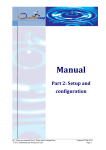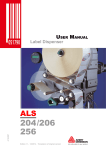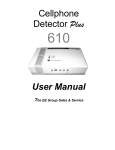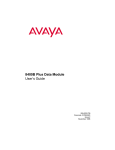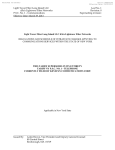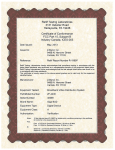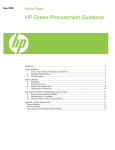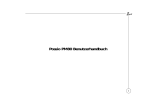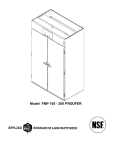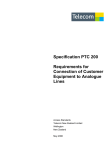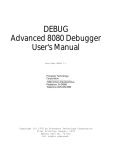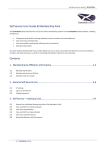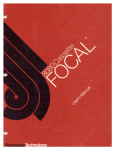Download PTC 213:2004 Requirements for Pay Telephones
Transcript
Specification PTC 213: 2004 Requirements for Pay Telephones DRAFT FOR PUBLIC COMMENT NOTE: This specification may be subject to amendment Access Standards Telecom Corporation of New Zealand Limited Wellington New Zealand April 2004 2 DRAFT FOR PUBLIC COMMENT © Copyright Telecom New Zealand Limited 2004 CONTENTS Page FOREWORD............................................................................................................................................6 1. 1.2 1.3 1.4 1.5 1.6 1.7 1.8 1.9 1.10 SCOPE........................................................................................................................................8 Associated Specifications ...........................................................................................................9 Legal requirements .....................................................................................................................9 Applications.................................................................................................................................9 Exclusions ...................................................................................................................................9 Mandatory requirements ...........................................................................................................10 Warnings to Suppliers ...............................................................................................................10 Supplier responsibility ...............................................................................................................11 User Manual..............................................................................................................................11 Warning to customers ...............................................................................................................11 2. GENERAL .................................................................................................................................13 2.1 Mode of presentation ................................................................................................................13 2.2 Marketing features ....................................................................................................................13 2.3 General Specifications and test requirements ..........................................................................13 2.3.2 Electrical safety requirements..............................................................................................13 2.3.3 Data and control functions ...................................................................................................14 2.3.4 EMC requirements ...............................................................................................................14 2.3.5 Ongoing compliance and general conditions ...................................................................15 2.4 Telepermit applications .............................................................................................................15 2.5 Customer and Supplier responsibilities.....................................................................................15 2.5.1 Responsibility for call charges .............................................................................................15 2.5.2 Responsibility for accommodation and location ...............................................................16 2.5.3 Responsibility for maintenance ........................................................................................16 2.6 Use with extension telephones .................................................................................................16 2.7 Variants of the same design .....................................................................................................17 2.8 Disabling of prohibited features ................................................................................................17 2.9 Testing procedures ...................................................................................................................17 3 DEFINITIONS .................................................................................................................................19 4 PHYSICAL DESIGN REOUIREMENTS ........................................................................................25 4.1 General Design .........................................................................................................................25 4.2 User instructions .......................................................................................................................25 4.3 Display of directory numbers ....................................................................................................26 4.4 Keypad layouts..........................................................................................................................26 4.5 Environmental aspects..............................................................................................................26 4.6 Pay telephone booths, kiosks, etc ............................................................................................26 5 SUPPLEMENTARY TECHNICAL REQUIREMENTS ...................................................................28 5.1 PTC 200 ....................................................................................................................................28 5.2 Exclusions from PTC 200 .........................................................................................................28 5.2.1 Incoming calls...................................................................................................................28 5.2.2 Payphone identification tone ............................................................................................28 5.2.3 Current/voltage characteristics.........................................................................................28 5.2.4 Network connection..........................................................................................................29 5.2.5 Facilities for the hearing impaired ....................................................................................29 6 SECURITY CONSIDERATIONS ...................................................................................................30 6.1 General .....................................................................................................................................30 6.2 Protection and Security .............................................................................................................30 6.3 Wiring Security ..........................................................................................................................30 4 DRAFT FOR PUBLIC COMMENT 6.4 6.5 6.6 6.7 Transmission Security...............................................................................................................30 Call control and charging software............................................................................................31 Call blocking..............................................................................................................................31 Toll barring ................................................................................................................................31 7 SPECIAL TONES AND SIGNALS .................................................................................................33 7.1 Pay telephone identification tone ..............................................................................................33 7.2 Credit expiry warning (“pay tone”).............................................................................................33 7.3 Use of other tones.....................................................................................................................34 8 TARIFFS AND REVENUE COLLECTION FACILITIES .................................................................35 8.1 Telecom tariffs...........................................................................................................................35 8.2 Pay telephone charging schemes.............................................................................................36 8.3 Metering pulses.........................................................................................................................36 8.4 Answer signals ..........................................................................................................................36 8.5 Notification of call charges ........................................................................................................37 8.6 Refund facilities.........................................................................................................................38 9 NUMBERING ARRANGEMENTS .................................................................................................39 9.1 Numbering scheme ...................................................................................................................39 9.2 Directory numbers.....................................................................................................................39 9.3 National numbers ......................................................................................................................39 9.4 International numbers ...............................................................................................................40 9.5 Special numbers .......................................................................................................................40 9.6 Operator-assisted calls .............................................................................................................41 9.7 Geographical variations ............................................................................................................41 NEW ZEALAND COIN CHARACTERISTICS ..........................................................................43 10 10.1 Specifications for New Zealand coins .......................................................................................43 10.2 Coin validation...........................................................................................................................43 11 11.1 11.2 11.3 11.4 REMOTE SUPERVISION AND CONTROL FACILITIES ........................................................45 General .....................................................................................................................................45 Technical requirements.............................................................................................................45 Remote supervision ..................................................................................................................45 Security.....................................................................................................................................45 SCHEDULE OF TEST RESULTS AND INFORMATION TO BE SUBMITTED.......................................1 5 DRAFT FOR PUBLIC COMMENT PTC 213: 2004 TELECOM DISCLAIMER Telecom makes no representation or warranty, expressed or implied, with respect to the sufficiency, accuracy, or utility of any information or opinion contained in this Specification. Telecom expressly advises that any use of or reliance on such information is at the risk of the supplier. Telecom shall not be liable for any damage or injury incurred by any person or organisation arising out of the sufficiency, accuracy, or utility of any such information or opinion. This Specification provides information, warnings and advice on possible fraudulent operation and the means of overcoming such problems. However, it is not possible for Telecom to define a comprehensive series of tests which could guarantee protection against all forms of fraudulent operation. Telecom has provided this information to assist suppliers and will expect the basic operations of a pay telephone to be tested to ensure that the product does operate as claimed by the supplier. The grant of a Telepermit in no way indicates Telecom acceptance of responsibility for the correct operation of a pay telephone under all operating conditions nor does it indicate that there will be complete protection from fraudulent calling. It must be recognized by all concerned in the supply and provision of pay telephone services that the lessee of a Telecom line is responsible for ALL call charges originated from that line, independent of whether a call was authorized by that lessee. In view of this basic principle, it is important that pay telephone suppliers ensure that their products bill all calls appropriately and that these products provide an acceptable level of protection against fraudulent calling. 6 DRAFT FOR PUBLIC COMMENT FOREWORD This Specification covers Telecom’s requirements for any pay telephone which is to be connected to the Telecom Public Switched Telephone Network (PSTN). This 2004 edition replaces and updates the original 1990 edition. While most of the telephony-related requirements are covered by Specifications TNA 102 and PTC 200, pay telephones involve the specification of a number of other parameters in order to ensure full compatibility with the network and a reasonable level of security against fraudulent calling. In addition, because the various types of pay telephone involve the collection of revenue from the user it is important that all parties concerned with their provision and use are fully aware of the conditions applicable to their operation. This is particularly important in respect of pay telephones available to the general public. Such telephones not only have to provide accurate and fair charging arrangements, but also need to be proof against fraudulent operation in all respects. In addition, their operation is subject to the requirements of the Fair Trading Act 1986 and Consumer Guarantees Act 1993. A customer installing any form of pay telephone on a Telecom line will be responsible for all charges debited to that line, irrespective of whether those charges were due to genuine or fraudulent calls. This Specification provides some information on the means of avoiding or minimising fraudulent calls, but it is not possible to deal with all eventualities, since the degree of risk is dependent on the particular pay telephone design, its location and its mode of operation While this Specification deals with most of the issues which have to be attended to, it must be stressed that the provider of any payphone is responsible for ensuring that his customer is satisfied with the service provided by that telephone. The granting of a “Telepermit” indicates only that Telecom permits the connection of a particular item to its network. In no way does such a grant infer that Telecom accepts responsibility for its correct operation under all possible service conditions, the security of any cash, or the degree of protection against fraudulent operation or vandalism. WARNING The attention of all Suppliers is drawn to the fact that the Telecom network provides for automatic message accounting with detailed customer call accounts for national and international calls and bulk billing for local business calls. Meter pulses are not used within the network and thus cannot be transmitted to line to facilitate call charge determination by pay telephones. 7 DRAFT FOR PUBLIC COMMENT PTC 213: 2004 STD/ISD pay telephones and any associated control equipment must therefore incorporate the necessary intelligence to determine all call charges. Suppliers will also need to refer to information which is regularly published on the Telecom website on numbering and tariff changes. These issues are likely to impact on the operation of all pay telephones and there is a need to provide for flexibility of charging and control facilities in any pay telephones, especially those offering STD or ISD services. 8 DRAFT FOR PUBLIC COMMENT 1. SCOPE 1.1 Types of pay telephone covered (1) This Specification relates to the requirements for all types of pay telephone, whether used for public or private services and independent of the means of revenue collection. It thus covers all pay telephones intended for use with the Telecom Public Switched Telephone Network, including: (a) Standard telephones associated with any form of revenue collection system as a separated unit. • A separate coin collection mechanism providing call duration timing and barring facilities for some classes of call would be a typical example. (b) Purpose-designed “local call only” pay telephones (c) Purpose-designed “local/STD/ISD” pay telephones (2) This Specification deals only in general terms with the means of revenue collection. This may involve the use of standard New Zealand coins, special tokens, credit cards or debit cards. Telecom applies no restriction on the actual method used, but does require evidence that the system is accurate and effective as one of the conditions for the grant of a “Telepermit”. (3) Telecom reserves the right to decline the grant of a Telepermit for products which are clearly not suitable for the intended purpose where it is likely that such a grant would bring the “Telepermit” system into disrepute. • While the supplier is held responsible for accurate and effective charging and for reasonable security against fraudulent calls, it is important that the Telecom Telepermit process is not brought into disrepute through the use of unsatisfactory pay telephones. Wherever problems arise Telecom is likely to be faced with costly investigations and adverse criticism from those directly affected. For these reasons, it is required that evidence be submitted to show the effectiveness of any design in these respects. (4) In general, pay telephones may be divided into two classes. Those used in “supervised locations”, such as shops and hotels, may be of relatively light weight construction. Those used in “unsupervised locations” such as public street access telephone kiosks, need to be robustly built to deter and provide protection from vandals. (5) This Specification does not set any minimum construction standards for the two classes, but does require that the supplier makes the product in a form suitable for its intended purpose and advises a customer accordingly. 9 DRAFT FOR PUBLIC COMMENT PTC 213: 2004 1.2 Associated Specifications This Specification shall be read in conjunction with Specification TNA 102 which covers the general interface requirements for equipment connected to the Telecom Public Switched Telephone Network (PSTN); and with Specification PTC 200, which covers telephone performance and other related requirements for compliance with Telecom’s analogue telephone lines. 1.3 Legal requirements (1) As stated in Telecom’s Terms and Conditions of Telephone Service, and in Specification PTC 100, only that equipment granted a “Permit to Connect” and bearing the appropriate “Telepermit” label may be connected to the Telecom network. (2) This agreement or permission to connect a product is granted in accordance with the provisions of S.106 of the Telecommunications Act 2001. 1.4 Applications (1) STD and ISD pay telephones may be connected only to individual telephone lines having automatic number identification (via a PABX if necessary, as explained in (3) below). (2) While pay telephones will generally be directly connected to individual exchange lines, there is no restriction against their use on extensions to PABX systems in customers’ premises. • It should be noted that the need to use a prefix digit for access to the public exchange may be confusing for users, but this requirement can be covered by the provision of a suitable notice on or near the telephone. (3) Any special applications not adequately covered by this Specification or specific to a particular payphone product will be dealt with as part of the processing of a Telepermit application, taking into account the relevant technical and policy implications. • As an example, Telecom policy excludes direct assistance to another operator in the collection of pay telephone revenue. 1.5 Exclusions (1) This Specification covers equipment designed for connection to standard Telecom network interfaces. Equipment to this Specification may not be suitable for connection to lines serving PABX system-dependent telephones or other types of equipment which require special network connections or interfaces. 10 DRAFT FOR PUBLIC COMMENT (2) Special purpose equipment used only in small quantities and not offered for sale to the general public may be exempted from some of the requirements of this Specification. Typical examples are equipment designed specially for the hard of hearing or handicapped people. All requests for such exemptions will be subject to negotiation between Telecom and the applicant. 1.6 Mandatory requirements Compliance with all relevant clauses of this Specification shall be regarded as the minimum set of requirements for the granting of a Telepermit. These selected clauses are indicated in the test schedule specified in Appendix 3 of PTC 200, together with the additional “payphone specific” points specified in Appendix 1 of this Specification. The latter are regarded as typical only and it may be necessary to include other tests where special facilities exist in or special operating conditions apply to the pay telephone under test. 1.7 Warnings to Suppliers (1) Notwithstanding the acceptance for Telepermit purposes of testing to selected clauses of this Specification, as outlined in clause 1 .9 (1), suppliers desiring maximum compatibility with the Telecom network should ensure that their equipment fully complies with all relevant requirements of both this Specification and PTC 200. (2) It is not possible to guarantee compatibility in every conceivable situation and, similarly, it is not possible or practicable for Telepermit testing to cover every situation. Nevertheless, the majority of operating conditions are covered by the simplified testing requirements defined in Appendix 1. (3) It is important that the suppliers of pay telephones appreciate that Telecom holds the lessee of a line responsible for all call charges incurred from that line. Thus, should there be fraudulent calls, inaccurate or unreliable charging, or any other failing of the pay telephone which results in the Telecom customer losing money, the supplier may be called upon to pay compensation. (4) The granting of a Telepermit is primarily dependent on compliance with the technical interface and safety requirements. While tariff issues are explained in this Specification to assist a supplier, such issues are wholly the responsibility of the suppliers and their customers, all of whom are required to comply with the requirements of New Zealand law. • Those concerned in the sale of pay telephones or in the offering of pay telephone services to other parties will need to refer to the Fair Trading Act 1986 as regards the clear notification of charges, call durations, etc, to ensure that their arrangements comply. 11 DRAFT FOR PUBLIC COMMENT PTC 213: 2004 • Where testing indicates that a product will not comply with these requirements or, for example, does not provide accurate charges, a Telepermit may be withheld until remedial action has been taken. (5) While this Specification provides warnings and advice on possible fraudulent operation and the means of overcoming such problems, it is not possible for Telecom to define a comprehensive series of tests which would guarantee protection against all potential forms of fraudulent operation. Similarly, for security reasons, it is not possible for Telecom to provide comprehensive advice on possible means of defrauding a pay telephone. • Such information is often available from the pay telephone manufacturer, who will generally have taken reasonable precautions to protect the security of the product. 1.8 Supplier responsibility (1) Telecom has provided the information in this Specification to assist suppliers, but will expect all of the basic operations of a pay telephone to have been thoroughly tested by the supplier or his agent to ensure that the product operates correctly in the New Zealand environment. (2) The grant of a Telepermit in no way indicates Telecom acceptance of responsibility for the correct operation of any pay telephone and its associated equipment, nor does it imply complete protection from fraudulent calling under all possible operating circumstances. (3) The supplier will be responsible for any design aspects which are not specifically covered by PTC Specifications, but which may impact on the suitability or otherwise of any particular design of pay telephone equipment supplied. 1.9 User Manual (1) Every pay telephone shall be provided with a user manual covering the operation and setting-up of that telephone when it is connected to the Telecom network. (2) The manual is to cover all aspects of the pay telephone’s operation for which the supplier expects the customer to accept responsibility. This will include such matters as its connection and environment, any need for supervision, charge and revenue verification. 1.10 Warning to customers (1) It is most important that prospective customers for pay telephones are made aware of their obligations to Telecom and the potential risks of fraudulent calling. 12 DRAFT FOR PUBLIC COMMENT (2) In view of this, all pay telephone user manuals shall include a clear warning, along the following lines:“Under Telecom’s Standard Terms and Conditions, the lessee of a Telecom line is responsible for paying for the services provided, no matter who uses them. Where you are installing a pay telephone which you are making available for use by other parties, you will need to ensure that you recover Telecom’s charges for all calls made by those parties. It is your responsibility, in conjunction with the supplier of the pay telephone, to ensure that all Telecom charges are recovered. Telecom does not and cannot accept any such responsibility.” (3) This warning may be a separate sheet firmly attached to the user manual. It is not intended that the manual be re-printed solely for the purposes of adding this warning. 13 DRAFT FOR PUBLIC COMMENT 2. PTC 213: 2004 GENERAL 2.1 Mode of presentation Those aspects of this Specification which are regarded as mandatory are printed in plain type with each paragraph formally numbered. Comments, recommendations and explanations, which are added only as indications of the means of compliance with this specification, are shown in Italics. Smaller type is used and each paragraph is preceded with a “.“ symbol instead of a clause number. 2.2 Marketing features Those characteristics of any equipment’s design which have no direct affect on its basic functions when connected to the Telecom network, and which may be regarded primarily as additional features of advantage to its competitive marketing, are not dealt with in this Specification. However, an explanatory note will be provided to clarify the position when some aspect is not a requirement of this Specification for Telepermit compliance purposes. 2.3 General Specifications and test requirements 2.3.1 Network compatibility (1) For any application for a Telepermit to be successful, equipment shall comply with all relevant requirements of the following Specifications: TNA 102 Telephone Network General Interface Conditions PTC 200 Requirements for the Connection of Customer Equipment to Analogue Lines • In some cases, particular clauses of Specification TNA 102 have been mentioned to assist the Applicant in understanding the requirements of this Specification. All other relevant aspects of Specification TNA 102 still apply to the equipment covered by this Specification, even though they may not be specifically referred to. • These specifications are published free of charge “on-line” at www.telepermit.co.nz (2) Where pay telephones are intended for connection to analogue lines, a test report to PTC 200, prepared by a Telecom-accredited test laboratory shall be submitted as part of the supporting documentation in any application for a Telepermit. 2.3.2 Electrical safety requirements (1) Compliance with all relevant requirements of AS/NZS/IEC 60950, ”Approval and Test Specification – Safety of information technology equipment including electrical business equipment” or a recognised direct equivalent of this standard is mandatory. 14 DRAFT FOR PUBLIC COMMENT This is especially important where any metal or conductive components used can come into contact with the user. Test reports or certificates demonstrating compliance with such a standard shall be submitted with any application for a Telepermit. • AS/NZS/IEC 60950 is available from Standards New Zealand. • This requirement includes either isolation of the surface from any local power supplies and from the Telecom line or that the surfaces be firmly bonded to the local earth. • These precautions apply especially to such items as armoured handset cords, stainless steel or aluminium cabinet surfaces and keypad buttons, all of which are directly touched by the user. (2) Where a pay telephone incorporates a separate power supply for any of its internal functions, the power supply shall comply with AS/NZS/IEC 60950 and its wiring shall comply with The Electricity Regulations 1997 and any relevant New Zealand Electrical Code of Practice. (3) Auxiliary ports for maintenance diagnostics, programming or downloading of internal databases shall provide isolation between the Telecom line and any external device. (4) Where mains voltage is connected within any assembly associated with a pay telephone a clear warning notice to the effect “DANGER 230V WITHIN” shall be affixed to the cover. • Such a sign can have the side effect of reducing vandalism. 2.3.3 Data and control functions (1) Where a pay telephone incorporates some means of remote supervision and control via the associated Telecom line, such control systems are also required to comply with the electrical safety requirements of AS/NZS/IEC 60950. (2) Any such supervision and control equipment shall also comply with the relevant requirements of Specification PTC 200. 2.3.4 EMC requirements (1) Modern electronic pay telephones will generally contain a microprocessor for billing and other operating functions. As such, they are subject to the requirements of the Radiocommunications Regulations 2001 and all relevant associated Notices concerning limits applying to radio frequency emissions from all parts of the equipment concerned. Suppliers are required to obtain and hold a suitable test report as evidence that the product complies with these requirements. 15 DRAFT FOR PUBLIC COMMENT PTC 213: 2004 (2) Compliant products are to be marked with a “C-tick” to indicate to customers that the product may be lawfully used in New Zealand. (3) The importer of any product is responsible for EMC compliance and is required to apply for a Supplier Code Number (SCN). The supplier’s SCN is to be marked on the outside of the product, along with the “C-tick” compliance mark. • For further details, see www.med.govt.nz/rsm/standards/notices 2.3.5 Ongoing compliance and general conditions (1) Successful applicants shall undertake to comply with the requirements of Specification PTC 100 in respect of all product supplied for connection to the Telecom network. • This specification is published free of charge “on-line” at www.telepermit.co.nz (2) As outlined in Specification PTC 100, should any conflict arise between the requirements of general Specifications and those of this product Specification, the requirements of this Specification take precedence. 2.4 Telepermit applications (1) Suppliers wishing to apply for a Telepermit shall assemble the required supporting documentation and submit a completed Telepermit Application form, ensuring that a person authorized to represent the proposed Telepermit holder signs the declaration to comply with the general terms of PTC 100 and any special conditions relating to the grant of the required Telepermit. • The necessary forms are published free of charge “on-line” at www.telepermit.co.nz (2) A general checklist of the supporting documentation required is included on the Application Form. In the case of pay telephones, test reports are required to both PTC 200 and this Specification, along with colour photographs of the internal components and external appearance, and proposed user guide. 2.5 Customer and Supplier responsibilities 2.5.1 Responsibility for call charges (1) It is important that all persons involved in the provision and use of pay telephones appreciate that Telecom holds the lessee of a line responsible for all charges incurred from that line. • Where a pay telephone of any sort is used, it will be the customer’s responsibility to satisfy himself or herself that the equipment is secure against fraudulent operation and that adequate means are provided for recovering all charges incurred by that pay telephone. 16 DRAFT FOR PUBLIC COMMENT • It is recommended that all suppliers of pay telephones ensure that their customers are fully aware of this fact when negotiating a sale. (2) Where a customer’s line is capable of originating STD and lSD calls special attention needs to be given to security and protection from fraudulent calls. • The value of such calls can be appreciable and, in the event that a means of making fraudulent calls is discovered, a customer may not be aware of the problem until Telecom’s account for call charges is received. 2.5.2 Responsibility for accommodation and location (1) The customer arranging the connection of a pay telephone to a Telecom line is responsible for the provision of suitable accommodation for the equipment and for the suitability of its location. • Care needs to be taken regarding the degree of supervision that will be available in relation to the vandal resistance of any particular design. (2) The accommodation requirements for any pay telephone do not form part of this PTC Specification. • This Specification relates to the requirements of the pay telephone equipment and does not extend to its service applications. 2.5.3 Responsibility for maintenance (1) Any customer connecting a pay telephone to a Telecom line will be responsible for arranging all necessary maintenance and repairs. • Generally, such work will need to be carried out by the supplier or a designated service representative. • Pay telephones accessible to the public are especially subject to vandalism and abuse. In fact, the inventive prowess of vandals may be astounding. It is thus essential that the prospective customer ensures that the supplier will be able to support the equipment provided. (2) Unless special formal arrangements have been entered into with the supplier or customer concerned, Telecom will accept no responsibility for maintaining pay telephone equipment provided by other suppliers. 2.6 Use with extension telephones (1) The monitoring of a line or of a customer’s premises is not permissible under New Zealand law, except where the following conditions are satisfied: 17 DRAFT FOR PUBLIC COMMENT PTC 213: 2004 (a) Monitoring shall be carried out only by a network operator’s staff and only where such monitoring is necessary for the normal maintenance of the service concerned. (b) Equipment used shall not be capable of monitoring a line or premises without the user’s knowledge. • Section 216B of the Crimes Act 1961 refers. (2) In the circumstances, it is not desirable that pay telephones available for public use have extension telephones connected to the same line unless there is some form of line grabbing facility which gives control to the pay telephone. • This is not a formal Telecom requirement and there may be circumstances where the use of an extension telephone is quite acceptable, such as in clubs and boarding houses. • Some shop pay phones may often be sited at the front counter, with an extension for private use at some other location. There is no objection to such an arrangement as the user is not likely to make confidential calls in such open surroundings. 2.7 Variants of the same design In some circumstances, such as where there are different product names and detailed external design changes for marketing purposes, one series of compliance tests may be applied to several variants of the same basic electro-acoustic design. Further details are given in clause 2.5 of Specification PTC 200. • In such cases, a formal assurance will be required from the manufacturer that the variants do, in fact, incorporate identical electro-acoustics and Telecom reserves the right to check a sample of each variant on request. 2.8 Disabling of prohibited features Any prohibited features of a product designed originally for another network shall be permanently disabled before a pay telephone is released to the New Zealand market. Further details are given in clause 2.6 of Specification PTC 200. 2.9 Testing procedures In the interests of efficient testing, at minimal cost to the Telepermit applicant, it is recommended that information should be provided to the selected testing laboratory on the most suitable means of disabling any automatic disconnection or security facilities likely to be encountered during the test programme. • This requirement applies mainly to any protective systems incorporated into any control system associated with the pay telephone. 18 DRAFT FOR PUBLIC COMMENT • Some devices have automatic solid state controls intended to turn the device “ON” or “OFF” under specific signal conditions. Frequently, this process leaves insufficient time for test measurements to be made. Unless suitable procedures are provided by the supplier, it may be necessary for the testing authority to spend additional time defining suitable test methods. Such activity will normally result in additional cost to the Applicant • Such in formation will be treated in strict confidence by the testing authority. 19 DRAFT FOR PUBLIC COMMENT 3 PTC 213: 2004 DEFINITIONS 3.1 In general, definitions set by the International Telecommunications Union (ITU-T) apply throughout this Specification. Nevertheless, some such definitions are not particularly informative for those unfamiliar with telecommunications engineering. In the circumstances, some of these definitions are supplemented by explanatory paragraphs which elaborate on the formal wording. • Unless stated otherwise, those terms not defined by ITU-T are generally used in the manner defined by Telecom in these PTC Specifications. 3.2 Additional definitions are provided in Specifications PTC 100, TNA 102 and PTC 200. TNA 102 and PTC 200 also define many of the technical terms used in this Specification and provide background comment on some of those terms. Nevertheless, several definitions are repeated in this Specification in order to explain aspects which directly relate to equipment performance or network interface conditions. 3.3 Definitions relevant to this Specification are as follows: Calling card: a card issued by Telecom which allows a call from any location to be charged to the customer’s home or business account, rather than to the telephone line used for the call. Coin free calls: calls to services, such as the 111 Emergency Service, 0800 numbers and service numbers, for which it is not necessary to insert coins. Coin telephone: any pay telephone designed to accept coins as the means of payment. • For the purpose at this Specification, only standard New Zealand coins are considered for this class of pay telephone. Credit card: any form of payment authorisation card which can be used in a pay telephone designed to transfer the cost of a call to the appropriate credit card account. • The use of standard credit cards for telephone calling purposes is not restricted by Telecom, but does need close co-operation between a pay telephone service operator and the credit card companies concerned. 20 DRAFT FOR PUBLIC COMMENT Customer: any person or organisation accepting service from Telecom under a formal contract for network service. • The term “customer” is used to describe the person connecting the pay telephone to the Telecom network, as distinct from the ‘user’ who makes casual use of that pay telephone. • Where the customer is a company offering a public pay telephone service, the same general conditions apply. However, Telecom will consider special arrangements for such companies where requested. Debit card: any form of prepaid card used with a pay telephone instead of coins, credit cards or tokens, and designed such that the available credit can be progressively cancelled by the amounts charged for calls. • As an example, some of the STD/ISD pay telephones (“CardPhones”) used by Telecom are classed as “Debit Card” or “Pre paid Card” telephones. • Another widely-used example is Telecom’s “YABBA” card, which allows calls to be routed via an 0800 number. Escrow: a temporary coin or credit store from which the pay telephone is able to return unused credit to the user, and to charge for a call by debiting a card or transferring coins to a secure cash box. Follow-on Call: the facility to allow a second or subsequent call to be made using credit already established for an earlier call without the need to claim a refund and reinsert credit. • This facility is useful in cases where only “best fit” refunds can be given as it gives the user the opportunity to make better use of any available credit Handover: is the process of transferring a call, which is in progress, from one item of terminal equipment to another while maintaining the connection. • Handover is not usually an issue with pay telephones as it is recommended that they are not used in conjunction with other extension telephones Handset: is a rigid combination of telephone microphone and telephone receiver in a form convenient for holding simultaneously to mouth and ear respectively. • For the purposes of this Specification, no distinction is made between a “handset” which is totally self-contained and simply “associated” with the main equipment and a “handset” which contains only the transducers, the associated transmission and signalling circuitry being housed within the main equipment 21 DRAFT FOR PUBLIC COMMENT PTC 213: 2004 Handsfree facility: is the provision of a loudspeaker and amplifier within the equipment such that telephone calls may be initiated without the use of a handset. • Hands free operation may be used as a means of protection against vandalism. This avoids the need to provide a handset and cord, both of which are frequent targets for vandals. Hookswitch: is the general term to cover any switch or other device operated when the handset is returned to its normal rest position. • For the purposes of this Specification, the term “hooks witch” also includes any control buttons or internal functions used to break the line connection and thereby initiate or terminate a call. • “On-hook” and “off-hook” are the terms used to describe the idle and in-use conditions of any equipment Hookswitch flash: is the momentary operation by the user of the hookswitch to perform a “recall” function. • This causes a brief interruption to the line current, but the duration is not long enough to be interpreted as the completion of the call. ISD (International Subscriber Dialling): the facility whereby customers can direct dial to overseas numbers. • Sometimes referred to overseas as “International Direct Dialling or “IDD” Line grabbing: is the facility, whether under manual or automatic control, whereby an item of equipment may disconnect any other terminal equipment from its line and seize that same line to either terminate or initiate a call. Local call only pay telephone: cannot be made. any pay telephone from which STD or ISD calls • ‘Toll barring” may be incorporated within the telephone or may be arranged by Telecom as a network function on request from the customer concerned. • Such telephones may provide a fixed duration call or have facilities to advise the user of the need to insert further coins if a call is to be continued. Loudspeaking facility: is a facility to permit several people to take part in a telephone conversation by incorporating an amplifier and a loudspeaker for the reception of incoming speech. 22 DRAFT FOR PUBLIC COMMENT • A loudspeaking facility normally also incorporates a microphone which is designed to pick up speech in the near vicinity of the telephone set • Loudspeaking facilities may be used in place of a conventional handset and cord as a protection against vandalism. Monitoring facility: is the provision of facilities to overhear a call such that call progress can be monitored without actually taking part in that call. Payphone identification tone (Cuckoo tone): an internationally standardised tone supplied for a short period and used to identify a pay telephone for any originated or terminated call. • Cuckoo tone has been adopted by most countries to ensure that assistance operators are not misled by fraudulent callers attempting to make transfer charge or collect calls to a pay telephone. Pay telephone: the general term used to describe any telephone equipment intended to collect a fee from the user for each successful chargeable call. Pay tone (or credit expiry tone): an audible indication that the user should insert coins or additional credit to pay for a call. • This tone will need to be transmitted to line where post payment operation is used. Otherwise, the called party may hang up in the event that there is no speech while the caller inserts coins. Post payment: the mode of operation whereby a user dials the wanted number and inserts coins or credit only after the called party answers. • This arrangement has not been used in New Zealand but there are no objections to its operation provided that a clear standard indication is given to the called party to avoid confusion. Pay tone is generally used for this purpose. Prepayment: the mode of operation whereby a user inserts coins or credit before the call is connected to the number dialled. • This is the arrangement which has been used throughout New Zealand for many years. Private pay telephone: a pay telephone installed in private premises and accessible only to those persons who are given access to those premises. • Typically used in hotels, boarding houses and clubs, such telephones may provide free local calls but allow any STD / ISD calls to be separately charged so that the lessee of the associated Telecom line can ensure that all toll charges are recovered at the time the call is placed. 23 DRAFT FOR PUBLIC COMMENT PTC 213: 2004 Telecom PSTN: is the Public Switched Telephone Network provided by and operated by Telecom in New Zealand. • The PSTN also includes other switching systems which may be installed in private premises, but which are directly connected to the PSTN. • Equipment suitable for the PSTN is also, by definition, normally suitable for use with PABX and key Telephone Systems (KTS). Some systems however require special purpose-designed equipment described as ‘system dependent’ telephones or terminals in order to provide their particular features. Equipment with standard interfaces complying with this Specification may not be suitable in such cases. Public pay telephone: any pay telephone accessible to the general public and providing service for any user. Ringer: is any device which responds to the alternating (ringing) voltage applied to a telephone line to provide a terminal equipment user with an indication of an incoming call. • The term “ringer” includes bellsets, and electronic tone callers of any type. It also includes devices which signal by optical or any other means. Service call: any call to a Telecom service for which Telecom levies no charge. • Examples are ‘111’ calls to the Emergency Services and calls to Telecom’s various customer support services, such as 120, 123, 125, etc. Shop pay telephone (or Shop phone): a specific form of pay telephone intended for use in supervised installations and usually providing some form of control facility for the owner or lessee to make calls free of charge. • The use of a Shop pay telephone is not confined to shops. The term is used to cover any installation which is accessible to members of the public and has the facility to revert to a non-pay mode under local control. Typically, a key operated switch is used for changeover purposes. • Such units do not usually need a high level of vandal resistance as they are sited within full view of the customer’s staff STD (Subscriber Toll Dialling): the facility whereby customers may direct dial calls to distant numbers for which call charges are at rates other than unit tariff. Supervised location: any location of a pay telephone, where it is reasonable to expect that the customer, or some other authorised person, will usually be present to ensure that the equipment is not subjected to abuse or vandalism. 24 DRAFT FOR PUBLIC COMMENT • See also “unsupervised location” • Supervised locations typically include shops, hotels, and clubs, main railway stations and airport concourses. Supplier: the person or organisation offering pay telephone equipment for sale or lease to Telecom customers. • The Supplier will generally be the Telepermit holder or will have some contractual arrangement with the Telepermit holder. In all cases, the supplier will be required to provide clear and comprehensive information to any Telecom customer contemplating purchase or lease of a pay telephone, such that the customer is in no doubt regarding the conditions applicable to its operation. • In the case of a public pay telephone company, the supplier may also be the Telecom customer leasing the lines concerned. While this situation makes no difference to the responsibility for all call charges incurred, Telecom may consider the provision of additional support facilities or special billing arrangements in such cases. Toll barring: any facility which prevents the origination of calls for which the Telecom charge exceeds the local call fee. • Almost all calls commencing with digit “0” are STD calls. However, there are some such calls for which Telecom may make no charge to the user, e.g., ‘0800’ calls. • Telecom uses local call charging at a fixed charge per minute for all business lines. Unsupervised location: any location where it is unlikely that any responsible person will be present to guard against vandalism. • A roadside public telephone is a typical case of an unsupervised location. User: any person making use of a pay telephone. • The term “user” is used in this Specification to refer to any person making use of a pay telephone, whether or not that person is also the Telecom customer leasing the line concerned. • The general situation is that ‘users’ have no special knowledge of the pay telephone and its operation, hence the need for clear ‘user instructions”. 25 DRAFT FOR PUBLIC COMMENT 4 PTC 213: 2004 PHYSICAL DESIGN REOUIREMENTS 4.1 General Design (1) There are no formal Telecom requirements for the physical design or robustness of the pay telephone equipment, other than as regards the assurance of electrical safety and the clarity and durability of the operating instructions, as dealt with in this Section. • All other physical design aspects are regarded as “Marketing features”. (2) As a general requirement, all pay telephone equipment shall be suitable for the purpose for which it is intended and, as such, it is important that a supplier gives clear information to prospective customers as to any limitations in the use of the equipment concerned. • For long term reliability the design of pay telephones, particularly those accessible to the public and installed in unsupervised locations, demands many special measures. It is recommended that suppliers take particular care in selecting potential installation sites to ensure that the equipment has a reasonable chance of surviving likely misuse. 4.2 User instructions (1) The pay telephone shall be provided with clear user instructions, either on the body of the telephone or on an associated notice sited close to the telephone concerned. • Confusion due to poor user instructions, especially if this results in the loss of cash, is a primary cause of user frustration and subsequent malicious damage. • It is also necessary that the user instructions or features of the pay telephone itself clearly explain minimum call charge, call tariffs and any maximum call durations which may apply. Any conditions regarded as unfair by the user are likely to result in retaliation. (2) The instructions shall clearly advise the procedure for calling the Emergency Service number ‘111’, clearly stating that such calls are free of charge. • Bold print with red lettering is recommended, as this is more prominent, especially where the emergency calling instructions are included within an extensive overall set of instructions. See also clause 5.3. (3) To facilitate operation during emergency ‘111’ calls from those telephones, especially for those used in unsupervised locations, a label or notice shall be provided to advise the user of the street address of the pay telephone location. • A suitable label or notice on or beside the telephone is acceptable. However, it is recommended that the street address be included within the emergency calling instructions. 26 DRAFT FOR PUBLIC COMMENT (4) The instructions shall clearly state the method of operation of the pay telephone, covering all the various classes of call for which there are differences in the operating methods or the types of coin or payment that may be used. • Pictograms are recommended as these can be more suitable for use by non-English speaking users. (5) The instructions shall clearly explain when a refund is applicable and show how any such refunds may be obtained. (6) The instructions shall be provided in a permanent form such that they are unlikely to be removed or obliterated by a user. 4.3 Display of directory numbers Since most unsupervised pay telephones are used for outcalling only and there is a risk of fraudulent calling should the directory number be known by users, there is no requirement to show this number on or near the telephone concerned. • The inclusion of a directory number label on or beside the telephone, or the publication of the directory number in any form will be a matter for the customer to decide. 4.4 Keypad layouts (1) The required layouts for keypads with both numeric and alpha-numeric designations are shown in Specification PTC 200. (2) Any additional facility keys for operating a pay telephone may be provided, as required by the specific functions of the unit concerned. 4.5 Environmental aspects (1) The Supplier is free to decide on the range of environments under which a pay telephone may be required to operate. • Adequate lighting, low ambient noise levels, reasonable privacy, etc, are typical environmental factors to be considered. • It is important that suppliers advise prospective customers of any environmental restrictions that apply to the use of a particular design. • It is recommended that suppliers advise their customers regarding appropriate locations and the availability of suitable enclosures. 4.6 Pay telephone booths, kiosks, etc (1) The physical design of any booths, kiosks, enclosures or mountings 27 DRAFT FOR PUBLIC COMMENT PTC 213: 2004 used for housing pay telephones are not covered by this PTC Specification. (2) Suppliers and their customers are free to choose any suitable arrangement for housing and wiring the equipment, subject only to compliance with electrical safety requirements, the Electricity Regulations 1997, and any relevant New Zealand Electrical Code of Practice. 28 DRAFT FOR PUBLIC COMMENT 5 SUPPLEMENTARY TECHNICAL REQUIREMENTS 5.1 PTC 200 (1) The main technical requirements for network compliance are published in Telecom specification PTC 200, which covers any products connected to Telecom’s analogue line interface. (2) This section covers technical matters specific to pay telephones and related products. 5.2 Exclusions from PTC 200 5.2.1 Incoming calls It is not mandatory that any pay telephone be equipped to receive incoming calls. • The use of pay telephones to answer incoming calls can increase the risk of fraudulent operation. • The ringing performance requirements of Specification PTC 200 will thus not apply where facilities are provided only for originating call, nor will these be any need to provide a directory number label on the pay telephone itself. 5.2.2 Payphone identification tone (1) Where pay telephones do provide facilities for answering incoming calls, the ringing facilities shall comply with Section 7 Specification PTC 200. (2) In all such cases, pay telephone identification tone is to be provided in accordance with Section 7 of this Specification. 5.2.3 Current/voltage characteristics (1) The objective requirement is full compliance with Section 6 of Specification PTC 200. Where this is achieved there will be minimal restrictions on the connection of a pay telephone to Telecom lines serving individual customers. (2) Where the energy requirements of a line-powered pay telephone result in direct current characteristics which do not comply with Section 6 of Specification PTC 200, a Telepermit may be granted subject to the conditions that any such telephone shall: (a) be connected only to Telecom lines with a loop resistance not exceeding some defined value based on the measured characteristics of the design, or (b) be locally powered when connected to lines with loop resistance exceeding the defined value referred to in (a) above. 29 DRAFT FOR PUBLIC COMMENT PTC 213: 2004 • Where a line is already in service, the loop resistance can generally be assessed by an installer by determining how much current can be drawn from the line with a termination of resistance equivalent to that of the pay telephone. • Since Telecom is not usually able to provide all lines within a fixed loop resistance limit, Option (b) is recommended as it allows the supplier to offer a pay telephone to almost any Telecom customer. (3) Any internal batteries may be charged from the Telecom line in the idle condition provided that the on-hook current drain does not exceed 1 mA for any Telecom line. • Revenue collection and control functions typically require more current than can be delivered from a 50 V transmission feed through a long line. As such, internal batteries are often required to deliver current peaks. (4) Where the on-hook current exceeds 400 microAmps, no other telephones or terminal equipment may be connected to the same line and, where applicable, instructions to customers are to clearly advise of this restriction. 5.2.4 Network connection (1) In the interests of security the network connection requirements of Section 10 of Specification PTC 200 are not mandatory. However, for the convenience of customers and support staff, the line connection should preferably be made by means of a standard British Telecom (BT) plug to BS 6312 and a 2-wire jackpoint. These may be internally mounted in the case of pay telephones intended for use in unsupervised locations. • This exclusion is provided so that there is no risk of a user unplugging the pay telephone from an exposed socket and simply replacing it with another telephone to avoid payment 5.2.5 Facilities for the hearing impaired (1) As with any other types of telephone supplied in New Zealand, it is not mandatory that a pay telephone provides facilities for use by persons equipped with a hearing aid. • Although this is regarded as a marketing feature, such provision is recommended. 30 DRAFT FOR PUBLIC COMMENT 6 SECURITY CONSIDERATIONS 6.1 General (1) Because pay telephones involve payments by the customer to Telecom and by the user to the customer, it is important that the charging system within the telephone be set up with regard to the charges which Telecom levies on the customer concerned. (2) Pay telephones will be called upon to determine the appropriate charges for each call and this will involve either the handling and storage of cash, or the management of transactions by means of debit or credit cards. In all such cases, there is need for adequate security. (3) By installing and providing pay telephones, customers are offering services to third parties, often to the general public. This increases the risk of fraudulent calling, theft of cash, rough usage and vandalism. • Several issues affecting security are dealt with in this Section, but other related matters are dealt with in the general text wherever this allows that matter to be better dealt with in the context of the topic concerned. 6.2 Protection and Security (1) Other than for safety aspects, which are defined by the relevant international standard, the Supplier is free to decide on the degree of vandal protection to be provided. Similarly, the supplier may decide on the degree of security to be provided for any cash containers or accounting records held within the pay telephone. (2) The supplier is responsible for advising the customer on the level of security appropriate for the proposed application. 6.3 Wiring Security Pay telephones may provide facilities for direct connection to the Telecom line within some form of secure enclosure. • This enclosure may be internal to the pay telephone cabinet or be provided as a separate cabinet. See also clause 5.2.4. 6.4 Transmission Security To reduce the risk of fraudulent operation, attention shall be given to the incorporation of facilities to suppress speech transmission in any circumstances where dialling is restricted by the control functions of the telephone. • Speech suppression restricts the use of hand-held DTMF generator units, such as those used for telephone number memory devices, which are designed to generate high levels of DTMF for 31 DRAFT FOR PUBLIC COMMENT PTC 213: 2004 acoustically coupling into the telephone mouthpiece. Such units have been used to circumvent the toll barring facilities of pay telephones. • This feature is especially important where the pay telephone has integral toll barring facilities. 6.5 Call control and charging software (1) It will be the responsibility of the supplier to ensure that any software or intelligence within the pay telephone is sufficiently resistant to interference by users that no calls can be made free or at charges other than those set within the charging software. • This requirement relates to any means of fraudulent calling, including the dialling of extraneous prefix digits, manipulation of the switchhook, coin or card jamming, or externally applied electrical fields. (2) While the Testing Authority will not be required to carry out a formal programme to confirm charging software security under all possible conditions, should any functional tests reveal that fraudulent calls can be made, the pay telephone concerned will not be granted a Telepermit. • The grant of a Telepermit in such situations would only bring the Telepermit system into disrepute. 6.6 Call blocking (1) Telecom sets no requirements on the classes of calls to be permitted. This is a matter to be decided by the supplier and customer. • For example, “0900” calls have very complex and varying relationships between the numbers dialled and the call charge, such that it would be difficult to ensure that the charges for such calls can be programmed into the pay telephone. • Similarly, since most service calls commencing with “1” are not charged by Telecom and “0800” calls are “free to the caller”, a pay telephone customer may choose to block them, rather than provide a free service to users.. (2) Where any classes of call are blocked, this is to be clearly explained to users, either in the written user instructions or in any payphone display. 6.7 Toll barring (1) Telecom will accept no responsibility for the effectiveness of toll barring or call blocking arrangements incorporated within a pay telephone. • Permanent toll barring facilities can generally be made available within the public exchange on an individual line basis. Each customer operating a pay telephone and requiring this facility will need to make a formal request to Telecom. (See also clause 8.4) 32 DRAFT FOR PUBLIC COMMENT (2) Where toll barring is required as a security feature to ensure that chargeable calls cannot be made from the line concerned, each payphone customer can subscribe to one or other of the toll barring options offered by Telecom. • Details of these options are published in the Telecom List of Charges under Call Control. See http://www2.telecom.co.nz/pdf/tloccall_tariffs.pdf 33 DRAFT FOR PUBLIC COMMENT 7 PTC 213: 2004 SPECIAL TONES AND SIGNALS 7.1 Pay telephone identification tone (1) In accordance with ITU-T Recommendation Q 35 all modern pay telephones shall provide “payphone identification tone” (generally termed “Cuckoo tone”). (2) Two separate frequencies shall be used, having a ratio of between 1.4:1 and 2:1 between the two frequencies selected. • Telecom has adopted 1209 Hz and 852 Hz as the two frequencies, as these are two of the DTMF tones already being generated for signalling purposes. (3) The recommended tone cadences are: f1 (1209 Hz): 200 ms “on”, 200 ms “off” f2 (852 Hz): 200 ms “on”, 2000 ms “off” repeated (4) The two tones shall be set at a level of not less than -20 dBm into a 600 Q termination. • Telecom has standardised on a level of -19 dBm for its own pay telephone services. (5) Payphone identification tone is to be extended to line for a period of at least 10 seconds whenever an incoming call is answered from a pay telephone. 7.2 Credit expiry warning (“pay tone”) (1) A visible and an audible indication shall be given to the user whenever a call is about to be terminated should further money or credit not be provided. • The dual warning facilitates use by handicapped users and use under adverse conditions. (2) User instructions shall clearly indicate the nature of the credit expiry warning. (3) Such indication shall be given in good time for the user to supply more credit before the call is automatically released. • Telecom recommends that at least 20 seconds audible warning be given prior to disconnection of the call. 34 DRAFT FOR PUBLIC COMMENT • It is recommended that audible warning tones be similar to those used by Telecom to avoid the risk of confusing a user. It is recommended that the credit expiry warning be given by means of a series of five “pips” of tone, with equal “on” and “off” periods, each of a duration of between 100 ms and 250 ins, with frequency in the range 600 Hz to 900 Hz. A level of approximately -27 dBm into the receiver of the telephone is also recommended. 7.3 Use of other tones The pay telephone supplier may make use any other special tones for the operation of the equipment, whether they are standard tones, as defined in PTC Specifications, or tones of quite different frequency and cadence, provided that: (a) such tones are not extended into the network in such a way that they will confuse other parties to telephone conversations, and (b) such tones do not conflict with the frequency and signal level requirements of Specification TNA 102. • While there is no objection to the provision of non-standard supervisory, call progress or other tones to assist the user of a pay telephone, the extension of such tones back into the network is not recommended. The aim of any network operator, including Telecom, is to keep the number of tones to an absolute minimum to avoid confusing customers. 35 DRAFT FOR PUBLIC COMMENT 8 PTC 213: 2004 TARIFFS AND REVENUE COLLECTION FACILITIES Warning It is recommended that all payphone suppliers refer to the Telecom website for the latest information on numbering and tariffs whenever programming a pay telephone. 8.1 Telecom tariffs (1) Local call charges apply for business customers and national call charges apply to both business and residential customers. All such changes will impact directly on the operation of pay telephones and the charges that they apply to users. (2) Telecom’s national call charges are based on a range of “Distance Steps” between the geographic toll area from which a call is made and the geographic toll area in which the call is terminated. Thus the charge for a call to any given number will depend on the location of the calling party. This means that any pay telephone providing for national calls will need to be programmed with the specific charges applicable from its intended location. Full details of these Telecom call charging steps are available on-line via http://www.telecom.co.nz/content/0,3900,2006551553,00.html (3) Telecom national and international call charges are subject to frequent changes for revenue promotion and marketing purposes, and call charge caps apply in some circumstances. There are variations in charges according to the time of day, weekends and holidays, etc. • Full details of Telecom’s call charges are published on-line at the following URL, which covers National, International, Mobile and special services calls, such as Teleconferencing, Calling cards, etc, etc. http://www2.telecom.co.nz/pdf/tloccall_tariffs.pdf (4) In addition, Telecom offers a range of discounts based on total annual or monthly bills, wholesaling arrangements, etc. Details of some of these are published on the above URL. • Payphone operators setting up significant numbers of payphones should contact Telecom to enquire about charging plans that would best fit their business arrangements. (5) Telecom’s own pay telephones use a simpler charging scheme, which “rounds up” the actual call charges that would apply to residential and business customers. These are published in the “Payphone Charges” section of the Telecom List of Charges, the URL for which is http://www2.telecom.co.nz/pdf/tlocpayphonecharges.pdf 36 DRAFT FOR PUBLIC COMMENT 8.2 Pay telephone charging schemes (1) It must be appreciated that pay telephone services are open to competition in the fully deregulated environment which now exists in New Zealand. As such, it may be desirable for the charges levied by pay telephones to be similar to the tariffs set by Telecom or another network operator, with some profit margin for the customer offering the service. Nevertheless, Telecom will have no involvement in the setting of charges for the use of pay telephones operated by other persons or organisations. • Suppliers and customers are free to set any tariffs they wish. (2) Whether or not any pay telephone operator wishes to offer national and/or international calls is a matter for that operator to decide. In view of the higher call charges involved and the complexity of numbering schemes, it is important that the payphone can provide software capable of determining appropriate charges for every call. Since it is not practicable to test every possible combination of number dialed and charge set, the capability of charging software will not be independently confirmed by Telecom as part of any Telepermit grant. Telecom will seek and rely on assurances provided by the pay telephone manufacturer. (3) Whether or not any pay telephone operator wishes to offer time-of day varying charges as used by Telecom is a matter for that operator to decide. However, where there is a desire to set time-related charges, it will be necessary to incorporate a real time clock in the pay telephone or its control equipment. Where this is provided, the supplier will be responsible for providing some suitable means of ensuring that it is accurate and does not vary to such an extent that there are any grounds for complaints under New Zealand consumer protection legislation. • This could occur where tariffs vary with time of day and, because of time error, a rate change does not occur at the times shown on any associated tariff notice. 8.3 Metering pulses Because the Telecom network is set up for Centralised Automatic Message recording, it neither uses nor provides any form of periodic metering pulses to line. All call charging functions thus need to be provided within the pay telephone or its associated control equipment. • It is important that any importer considering the purchase of overseas-designed STD/ISD pay telephones be aware of this point. Many overseas multi-fee pay telephones depend for their charging functions on metering pulses provided by the telephone network. 8.4 Answer signals (1) Except where a clear warning is given to users, call charging shall commence only on receipt of an answer signal or an answer acknowledgement given by the user. 37 DRAFT FOR PUBLIC COMMENT PTC 213: 2004 (2) Not all Telecom lines provide for an answer signal to be extended back to the calling telephone, but it will usually be possible to provide this signal on specific lines where it is required for the correct operation of a pay telephone. • Enquiries should be directed to Telecom. • It is recommended that the supplier advises prospective customers of the need to ensure that answer signals are available. (3) The standard answer signal used by Telecom is reversal of the voltage polarity of the line wires. • It is recommended that pay telephones provide some form of time-out to minimise the risk of long calls without an apparent answer signal 8.5 Notification of call charges (1) The actual charge set in a pay telephone for local calls is not defined by Telecom and may be set by each customer, usually in conjunction with the supplier. (2) The local call charge is to be clearly indicated to users. Whether such information is shown on the pay telephone user instructions or displayed after the user has dialed the initial digits of the wanted number is a matter to be decided by the customer. Nevertheless, it will be necessary to ensure that the charging arrangements are in accordance with the requirements of New Zealand consumer protection legislation. (a) Some calls commencing with digit “0”, e.g., “0800” and “012” may need to be regarded as calls which are free to the user. (b) “111” emergency service calls shall be handled free of charge. Calls to other widely-recognised emergency numbers, such as “911”, “999” , “000” and “112” may be treated as free calls, but this is not mandatory. (c) Special services calls commencing with digit ‘1’, other than “111” should preferably be handled as free calls (d) Calls dialled to a Telecom Assistance Operator using digits such as ‘010’ or “016” may be treated as local calls provided Payphone Identification tone is used for originated calls. However, this is not recommended for any supplier who does not have a suitable wholesaling agreement with Telecom that will ensure call charges are booked to the correct party. • It is important that there is no opportunity for fraudulent use such that call charges are debited to the customer providing the payphone service. 38 DRAFT FOR PUBLIC COMMENT (3) As a condition of the grant of a “Telepermit” and connection of any pay telephone to the Telecom network, service operators shall undertake to clearly identify all call charges which will apply in a manner which is not misleading to the user. (4) Where a display on the telephone is used, the minimum call fee shall be shown before the pay telephone transmits the final digit of the dialled number to the network • This arrangement allows the user to terminate the call before answer in the event that the call charge is unacceptable. (5) As stated in clause 8.3, no metering pulses are provided by the network and all pay telephones providing STD calling facilities will need to examine the digits dialled in order to determine the charge for a call. 8.6 Refund facilities (1) In the event of a call remaining unanswered all pay telephones shall: (a) make a full refund when the user releases the call, or (b) give a clear warning that no refund will be given, or (c) where only a partial refund will be given, shall provide the user with a clear warning to this effect, with details of the amount of refund to be expected. • Pay telephones making use of debit or credit cards will usually not charge until a call is answered. A refund should thus not be necessary. (2) Regarding (1)(c), where all available credit is not used by the time the user completes a call and goes “on hook”, then ‘best fit” coin refunds may typically be provided. • User instructions shall clearly describe the refund arrangements and any circumstances in which a refund of all remaining credit will not made. • Refunds may be delayed where facilities for “follow-on” calls are provided. 39 DRAFT FOR PUBLIC COMMENT 9 PTC 213: 2004 NUMBERING ARRANGEMENTS Warning It is recommended that all payphone suppliers refer to the Telecom website for the latest information on numbering and tariffs whenever programming a pay telephone. Details of network numbering and call charging steps are published on-line via http://www.telecom.co.nz/content/0,3900,200655-1553,00.html 9.1 Numbering scheme (1) The basic structure and principles of the Telecom PSTN numbering scheme are published in TNA 150. The following provides a brief outline of the main features. 9.2 Directory numbers (1) 7-digit directory numbers are now standard for all PSTN customers within the Telecom network. Local calls commence with any digit in the range “2 – 9”. (2) Calls commencing with digit ‘1’ are special services calls, some of which do not generate a call charge by Telecom or other network operators. • It is important that access be given to the standard Emergency Services number ‘111’ without a charge being levied by the pay telephone. See also clause 5.3. (3) Calls commencing with digit “0” generally incur charges. This digit is used to access the national and international networks, operator and other network services. • Widely-used exceptions to this generalisation are calls to “0800” and “0508” numbers, all of which are “free to the caller”. These are still chargeable calls, but the charges are paid by the called party. • An “05” prefix may give access to another network operator’s international service. Eg, “0501” (4) The charges for some calls commencing with digit “0”, such as “010” for operator assistance and “012” for Telecom Calling Card cannot be determined by a pay telephone. (5) Cellular mobile numbers use a mix of 7 and 8 digits for the customer number, preceded for payphone access by the access code for the mobile network concerned. 9.3 National numbers (1) For calls to numbers outside the local calling area, the prefix digit “0” is used. This also provides access to other networks, such as those provided by other carriers and mobile networks. 40 DRAFT FOR PUBLIC COMMENT (2) New Zealand is divided into five geographic areas for national calling. Each of these is indicated by one of the area codes “3”, “4”, “6”, “7” or “9”. The required directory number is dialed after the appropriate area code. (3) Access codes “2” and “5” are allocated to other networks and their services, which may include international calls. • The access codes currently in use for mobile networks are “021” for Vodafone, “025” and “027” for Telecom, and “029 for Telstra Clear. • Paging services use the access code “026” • Special care will need to be taken to analyse the digits following ‘02’ or ‘05’ to determine the appropriate call charges. 9.4 International numbers (1) International calls made via the Telecom network commence with digits 00’, followed by up to 15 digits. (2) Other network operators provide international services and each of these may use either a different prefix to access their individual network service, or, in some cases, make use of an “0800” number to access their service. • Use of an “0800” number means that any charge for accessing the other operator’s network service can be integrated into that operator’s overall service charge. (3) The relationship between the country code dialled by the user and the country designated by that code is published in the Telecom List of Charges. • See Section 10.2 of the TLOC, ref http://www2.telecom.co.nz/pdf/tloccall_tariffs.pdf This also shows the charge rates applicable from Telecom lines. • Country codes and some of the areas codes of principal cities are also shown in the International Section of Telecom Phone Books. 9.5 Special numbers (1) Some numbers fall outside the general rules outlined above. Some examples are given below. Nevertheless, it is the responsibility of the payphone customer to ensure that any equipment installed will either appropriately handle or bar any calls to numbers which could result in unacceptable charges being incurred. 41 DRAFT FOR PUBLIC COMMENT PTC 213: 2004 (2) Calls commencing with the digits ‘0800’ are free and may not be regarded as local calls for charging purposes. (3) Calls commencing with the digits ‘0900’ are special cases that need to be differentiated from calls to other numbers commencing with “09”. The Telecom 0900 Service enables a Telecom customer (the Information Provider) to offer information or promotions to, and receive information from, the general public. This is done via a telephone, at some pre-arranged cost to the caller. Telecom bills the calling line for each call to the 0900 number and passes on to the Information Provider that call charge less a flat rate per minute charge which is retained by Telecom for routing and billing the call. The 0900 set charge replaces any local or national call charges that would otherwise apply. These charges can be very high. For a pay telephone operator to provide access to 0900 calls and recover all call charges presents considerable difficulty. It is recommended that such calls be permanently barred. (4) Service calls, commencing with digit “1” are usually free of charge. In particular, calls to “111” shall be free of charge from any pay telephone. 9.6 Operator-assisted calls (1) Telecom and other New Zealand network operators provide a wide range of operator assistance services, including such matters as call completion following directory enquiries, collect calls, etc. Such calls may be dialled to the Telecom Assistance Operator using digits ‘010’ or using various other related numbers commencing with digits “01”. • Details of these services and the numbers used to access them can be obtained from Phone Books, the Telecom List of Charges, etc. (2) Collect calls may be made from pay telephones such that any toll and assistance charges are debited to another number. • Should any facilities be provided for users to dial “010” or any other operator assistance services, whether these are provided by Telecom or any other network operator, special care needs to be taken to ensure that fraudulent calls are not encouraged. In general, it is recommended that provision should be made for all such calIs to be barred within the pay telephone. 9.7 Geographical variations (1) Telecom national call tariffs are based primarily on call distance, so the relationship between the number dialled and the call charge will vary according to the actual location of the pay telephone from which a call is made. This means that any pay telephone intended to provide for national and/or international calls must have facilities for setting the call charge according to its location. 42 DRAFT FOR PUBLIC COMMENT (2) Call charges will have to be programmed into any “intelligent” pay telephones (based on the pay telephone operator’s own versions of the Telecom tariffs) in accordance with the final location of each unit concerned. • Because no meter pulses are available from the network, as in many other countries, it is often not possible to move pay telephone equipment from one area to another without actually reprogramming its internal tariff tables for the new location. This impacts on any processes used for service restoration whereby a faulty pay telephone needs to be replaced by another unit. PTC 213: 2004 43 DRAFT FOR PUBLIC COMMENT 10 NEW ZEALAND COIN CHARACTERISTICS 10.1 Specifications for New Zealand coins (1) The following table provides the dimension, weights and alloys used for New Zealand coins: Diameter mm Cupro-Nickel Fifty Cent Twenty Cent Ten Cent Five Cent 31.750 28.575 23.622 19.431 Aluminium Bronze Two Dollar 26.5 One Dollar 23.0 Diameter Tolerance ±mm Standard Weight Gram Weight Tolerance ± Gram Rim Thickness mm Rim Tolerance ± mm 0.125 0.125 0.125 0.125 13.608 11.31 5.655 2.828 0.075 0.065 0.038 0.023 2.3368 2.2987 1.7018 1.2446 0.127 0.127 0.127 0.127 0.125 0.125 10.0 8.0 0.03 0.024 2.51 2.74 0.127 0.127 (2) For the design of any pay telephones making use of modern electronic coin verification systems, the Reserve Bank of New Zealand has advised that: (a) the metallic content of the 5,10, 20 and 50 cent coins is 75% Copper and 25% Nickel (with a tolerance of ± 1%) (b) the metallic content of the $1 and $2 coins is expected to be 92% Copper, 6% Aluminium and 2% Nickel. 10.2 Coin validation (1) Any effective method of coin validation is acceptable to Telecom for Telepermit purposes. Whether sophisticated electronic methods or simple weighing and sizing systems are used will depend to a large extent on the range of calling facilities offered by the pay telephone. (2) The supplier is required to state that all reasonable care has been taken to ensure that the coin validation system is effective and that tests have been carried out with a range of coins and other items to verify this claim. • It is recommended that any prospective supplier takes especial care to confirm the effectiveness of the coin validation system, not only testing with a range of genuine coins of varying ages and wear, but also using foreign coins of similar types, washers, tokens, punchings, etc, of appropriate sizes and differing materials. This is the only way to ensure that the product will not be prone to fraudulent calling and possible claims from customers as a result (3) While the granting of a Telepermit will in no way imply that Telecom accepts any responsibility for the accuracy of the coin validation system used, should it be 44 DRAFT FOR PUBLIC COMMENT revealed during compliance testing that the coin validation is ineffective then this will be regarded as sufficient grounds for declining the grant of a Telepermit. 45 DRAFT FOR PUBLIC COMMENT 11 PTC 213: 2004 REMOTE SUPERVISION AND CONTROL FACILITIES 11.1 General (1) Pay telephone suppliers may adopt system designs which incorporate remote or centralised supervision or control equipment to control a number of pay telephones. However, for security and resource allocation reasons Telecom cannot permit such control equipment to be housed within its own telephone exchanges. (2) Where a data link is required between each pay telephone and a central control unit, this link may either use separate leased circuits or be connected to the same line as the pay telephone concerned. In the latter case all analogue line signalling used at the pay telephone shall comply with the requirements of Specification PTC 200 and all digital line interfaces shall comply with the relevant PTC specification. For leased circuits, Telecom will normally provide a suitable network termination unit at the pay telephone location and advise the interface requirements for that particular unit. 11.2 Technical requirements (1) The technical requirements of analogue interfaces presented to the Telecom network by any centralised control equipment shall comply with Specification PTC 200. • Suppliers should note that this condition automatically bars the private use of any control system using data over voice or any frequencies above the normal voice band provided by Telecom telephone lines, other than where ADSL is used on such lines. (2) The technical requirements of ISDN interfaces presented to the Telecom network by any control equipment shall comply with Specifications PTC 131, PTC 132, TNA 133 and TNA 134. 11.3 Remote supervision Remote supervision facilities for maintenance diagnostics and programming, security monitoring, or other functions may be equipped in any pay telephone. Such facilities shall comply with the appropriate PTC Specifications. • In view of the range of functions possible and the many modes of operation that might be used, it is not possible to define the relevant requirements in a general Specification and each special need will have to be considered according to its particular characteristics. 11.4 Security Any system of remote control using the actual pay telephone line provides a potential access to “hackers” or any other parties attempting to breach the security of the pay telephone in order to make fraudulent calls or simply prevent normal operation. It is the responsibility of the payphone supplier, in conjunction with the manufacturer, to ensure that all control systems are secure. 46 DRAFT FOR PUBLIC COMMENT • A typical security arrangement is to ensure the pay telephone control system or software cannot be directly accessed from an incoming call. The pay telephone may be programmed to generate a regular call to the remote control equipment to check for new software or be triggered by some means to call the remote control equipment when necessary. END OF SPECIFICATION PTC 213 – APPENDIX No. 1 FOLLOWS APPENDIX No. 1 1 DRAFT FOR PUBLIC COMMENT PTC 213: 2004 SCHEDULE OF TEST RESULTS AND INFORMATION TO BE SUBMITTED 1. GENERAL (1) Applicants shall submit a completed Telepermit application form for each specific model of pay telephone for which a Telepermit is requested, formally undertaking to comply with the requirements of Specification PTC 100, and ensuring that all other information detailed on the standard application form is supplied and verified correct. • Application forms are available on-line from www.telepermit.co.nz . • Note that the Undertaking to comply with PTC 100 General Conditions is to be signed by a New Zealand resident or by an authorized representative of a New Zealand Registered Company (2) Provide a general product description for each model, stating whether the pay telephone concerned is “Local only” or “STD and/or ISD capable”; whether it is intended for use in supervised or non-supervised locations, whether coin or card type, etc. • A product brochure and full user instructions may be submitted in response to this requirement, but it will be necessary to clearly specify any features of an overseas design that will not apply in the New Zealand version of the product. (3) Where there are variants of the design also being covered at the time of the application, and these variants have different product names or detailed external design changes, the application(s) are to clearly cover each such variant, explaining the differences between them. (4) The applicant shall either provide evidence from the manufacturer that these variants are all of the same basic electro-acoustic design and provide at least one sample of each variant, or provide a separate set of PTC 200 test results for each variant. (5) The applicant shall supply the Testing Authority with information indicating the principles of the charging arrangements and any typical charges programmed into the pay telephones under test. • This information will allow the Testing Authority to observe whether any incorrect charges or apparent anomalies result during the PTC 200 testing programme. (6) Where any security provisions integral within the product are likely to result in the testing authority not being able to carry out the necessary tests, the applicant shall 2 DRAFT FOR PUBLIC COMMENT arrange for the manufacturer to make available any necessary over-riding software instructions or methods to the testing authority nominated to carry out the work. • A formal non-disclosure or confidentiality agreement may be imposed on the parties concerned where necessary. (7) Where a pay telephone is remotely monitored or controlled for such purposes as downloading new tariff data or operating software, the control system will also need to connect, either directly or indirectly, to a public network. (8) Any such remote control or monitoring system connecting to the Telecom network shall be covered by a separate Telepermit application. 2. TELEPERMIT SUBMISSION DOCUMENTS (1) A Statement of Compliance in the form of a clause by clause response, as set out in this Appendix, shall be prepared for each model of pay telephone covered by an application for Telepermit. • It should be noted that many of the clauses of this Appendix may best be responded to by the manufacturer or applicant, rather than the Testing Authority. Some clauses may be completed by the independent Testing Authority according to the results of their tests if this course of action is preferred by the Applicant. • Note that the Applicant is held responsible for ensuring that these particular requirements are complied with and that they are frequently difficult to confirm by means of a simple series of laboratory tests. (2) Test Results to AS/NZS/IEC 60950 shall be submitted with the application, covering the pay telephone itself and any separate power supply units or battery chargers associated with it. (3) Subject to the specific relaxations and qualifications given in clause 4.3 and Section 5 of this Specification, test results to PTC 200, shall be submitted with the application. (4) Colour photographs of the interior and exterior of each payphone model shall be submitted with a Telepermit application. APPENDIX No. 1 3 DRAFT FOR PUBLIC COMMENT PTC 213: 2004 (5) The applicant shall supply a copy of the user instructions intended to be supplied, ensuring that such instructions are amended as necessary and provided for each variant of the pay telephone design where there are multiple applications. (6) Where applicable, the applicant shall supply a copy of the user manual intended to be supplied to Telecom customers who purchase or lease the pay telephone in order to provide a service to users. • A specific Telecom version will usually require extensive amendment of any user manual intended for pay telephones used in overseas markets. However, as an interim measure, the overseas version may be supplied initially. Any Telepermit granted will be conditional on the submission of a specific Telecom version prior to the product being connected by Telecom customers. 3. ASSOCIATED MONITORING AND CONTROL SYSTEMS Where a remote monitoring or control system is used, test results to the relevant PTC specification shall be submitted, together with the necessary supporting documentation to comply with sub-clauses (2), (4), (5) and (6) above. 4. EMC COMPLIANCE EMC requirements are administered by the Radio Spectrum Management group of the Ministry of Economic Development, not by Telecom. New Zealand operates a selfdeclaration system for importers of electrical and electronic equipment. All such importers will need to apply for a Supplier Code Number and mark this number, along with the “C-tick” compliance mark on all pay telephones used in New Zealand. 5. RESPONSES TO PTC 213 The following questionnaire is intended not only as a standardised format for indicating the level of compliance with this specification, but also as a checklist for suppliers of the parameters that need to be addressed when supplying pay telephones to Telecom customers. The overall aim is to ensure that all reasonable steps have been taken to avoid problems for those Telecom customers who choose to provide a pay telephone service for other users. 4 DRAFT FOR PUBLIC COMMENT RESPONSES TO SPECIFICATION PTC 213 NOTE Clause references relate to those used in the body of this specification. Where clauses or sub-clauses are omitted, no response is required. 1.1 Type of pay telephone (1) Is the pay telephone intended for local only, STD/ISD? ………………………….. (2) Is it coin, debit card or credit card? ………………………………………………….. (4) For what operating conditions is the pay telephone provided? …………………… eg, “supervised” or “unsupervised” 1.5 Exclusions Are there any special considerations to warrant exclusions from the requirements of this or other PTC specifications? ………………………………………………………………… ……………………………………………………………………………………………………… 1.9 User Manual Has a user manual been attached to this submission? YES/NO Is the user manual been amended to cover all operating conditions and requirements when the pay telephone is connected to the Telecom network? YES/NO 1.10 Warning to customers Does the manual include the required warning? 2. YES/NO GENERAL 2.3.2 Electrical safety requirements (1) Does the pay telephone comply with AS/NZS/IEC 60950? YES/NO (2) Where a pay telephone incorporates a separate power supply for any of its internal functions: Is there evidence to show that the power supply also complies with AS/NZS/IEC 60950? YES/NO (3) Do auxiliary ports for maintenance diagnostics, programming or downloading of internal databases provide isolation between the Telecom line and any external device? APPENDIX No. 1 5 DRAFT FOR PUBLIC COMMENT PTC 213: 2004 YES/NO (4) Where mains voltage is connected within any assembly associated with a pay telephone, is a clear warning notice to the effect “DANGER 230V WITHIN” affixed to the cover? YES/NO 2.5 Customer and supplier responsibilities Has the applicant taken steps to ensure that customers are aware of their responsibilities and obligations when connecting a pay telephone providing access to other users? YES/NO 2.8 Disabling of prohibited features Are all such features not applicable to the Telecom network permanently disabled? YES/NO (2) If YES, how were they disabled? ………………………………………………… …………………………………………………………………………………………………… 2.9 Testing procedures Was information provided to the test lab on the most suitable means of disabling any automatic disconnection or security facilities likely to be encountered during the test programme? YES/NO 4 PHYSICAL DESIGN ASPECTS 4.1 General design Has the applicant confirmed that the pay telephone should be suitable for its intended purpose? YES/NO 4.2 User instructions (1) Is the pay telephone provided with clear user instructions, either on the body of the telephone or on an associated notice to be sited close to the telephone concerned? YES/NO (2) Do the instructions clearly advise the procedure for calling the Emergency Service number “111” and provide for the location to be shown? YES/NO Does the pay telephone provide facilities for free-calling to the “111” emergency calling number without the prior insertion of coins or any other form of payment being needed to initiate the call? YES/NO 6 DRAFT FOR PUBLIC COMMENT (4) Do the instructions clearly state the method of operation of the pay telephone, and cover the various types of call for which there are differences in the operating methods and the types of coin or payment that may be used? YES/NO (5) Do the instructions clearly explain when a refund is applicable and show how any such refunds may be obtained? YES/NO (6) Are instructions provided in a permanent form such that they are unlikely to be removed or obliterated by users? YES/NO 4.4 Keypad layouts (1) What layout is used for the keypad? ……………………………………………… Are PTC 200 compliant alpha-numeric keypads provided? 5 YES/NO TECHNICAL REQUIREMENTS 5.2.1 Incoming calls Is the pay telephone equipped to receive incoming calls? YES/NO 5.2.2 Payphone identification tone Is pay telephone identification tone provided in accordance with clause 7.1? 5.2.3 Current/voltage characteristics (1) Is there full compliance with Section 6 of Specification PTC 200? YES/NO (2) If not:(a) what is the maximum loop resistance specified? ……………… Ohms or, what is the minimum line current for correct operation? …………………. mA (b) Is the pay telephone to be locally powered when connected to long lines or where the line current will not meet the value stated above? YES/NO (3) Are there internal batteries to be charged from the Telecom line in the idle condition? YES/NO If YES, what is the on-hook line current? ……………………………………….. mA APPENDIX No. 1 7 DRAFT FOR PUBLIC COMMENT PTC 213: 2004 (4) Where the on-hook current exceeds 400 microA, do instructions to customers clearly advise of the restriction on the connection of other telephones or terminal equipment to the same telephone line? YES/NO 5.2.4 Network connection Are there special termination requirements? YES/NO 5.2.5 Facilities for the hearing impaired Does the pay telephone provide facilities for use by persons equipped with a hearing aid? (Not mandatory) YES/NO 6. SECURITY CONSIDERATIONS 6.1 General Has the applicant understood the need for adequate security? YES/NO 6.2 Protection (2) Has the supplier taken steps to advise customers of the need for security to be appropriate for the intended application? YES/NO 6.3 Wiring security Is the connection to the network specially secured? YES/NO (not mandatory) 6.4 Transmission security Are there facilities to suppress speech transmission in any circumstances where dialling is restricted by the control functions of the telephone? YES/NO 6.5 Call control and charging software (1) Does the pay telephone incorporate some means of remote supervision and control via the associated Telecom line? YES/NO If YES, has the supervision and control equipment already been covered by a Telepermit application? YES/NO Were any instances of incorrect charging observed during PTC 213 testing? YES/NO 8 DRAFT FOR PUBLIC COMMENT If YES, please supply details on a separate sheet to be attached to this Test Report. 6.6 Toll barring Is reliance placed wholly on toll barring within the payphone or its control system? YES/NO 7 SPECIAL TONES AND SIGNALS 7.1 Pay telephone identification tone (1) Is “payphone identification tone” (generally termed “Cuckoo tone”) provided in accordance with this Specification? YES/NO If NO, please provide details of frequencies, cadences and levels ……………………. …………………………………………………………………………………………………… (4) What level is the tone set at? …………………………………………………… dBm (5) For what duration is the tone applied on answer? ………………………… secs 7.2 Credit expiry warning (“pay tone”) (1) What indication is provided? ………………………………………………………….. (2) Are user instructions clear? (3) What warning time is given before a call is dropped? YES/NO ………………….. seconds 7.3 Other tones (1) Does the pay telephone use other non-standard tones? YES/NO (a) Are such tones extended to the network? YES/NO (b) if YES, do such tones meet PTC 200/TNA 102? YES/NO APPENDIX No. 1 8 9 DRAFT FOR PUBLIC COMMENT PTC 213: 2004 TARIFFS AND REVENUE COLLECTION FACILITIES 8.2 Pay telephone charging schemes (1 ) Are the general principles of operation as regards call charging and toll tariff arrangements understood by the applicant? YES/NO (2) Is a real time clock and calendar incorporated in the pay telephone or its control equipment? YES/NO If so, what is their accuracy? ……………………………………………………………….. (3) Is some flexibility for varying call charge and/or duration provided? YES/NO 8.3 Metering pulses Are all call charging functions provided within the pay telephone without the need for any form of periodic metering pulses from the line? YES/NO If “NO’, is there associated control equipment which needs to be considered as part of this PTC application? YES/NO 8.4 Answer signals (1) How is call charging commenced? ……………………………………………………. ……………………………………………………………………………………………………… (2) Is there a need for a line reversal (answer signal) to be extended back to a calling telephone? YES/NO 8.5 Notification of call charges (2) Is the local call charge clearly shown on a display on the telephone or on the pay telephone user instructions? YES/NO (a) Can any calls commencing with digit “0” or “1”, e.g., ‘0800’, “120”, be regarded as free calls and displayed as such? (Not mandatory, but could be a useful attribute in some applications) YES/NO (b) Can “111” emergency service calls be handled free of charge? (Mandatory) (c) Can special services calls commencing with digit ‘1’, other than “111” YES/NO 10 DRAFT FOR PUBLIC COMMENT be handled as free calls? YES/NO (Not mandatory, but could be a useful attribute in some applications) (d) Can free calls be dialled to the Telecom Assistance Operator using digits ‘010’? YES/NO (Not mandatory and usually permissible only on public pay telephones intended to be operated by Telecom or on pay telephones intended for use in private premises) (3) Are other call charge/s clearly shown on a display on the telephone or on the pay telephone user instructions? YES/NO (4) YES/NO Is the minimum call fee shown prior to making a call? (5) Can the pay telephone determine national or international call charges based on the number dialed? YES/NO 8.6 Refund facilities (1) (a) Is there a refund facility if a cal remains unanswered? 9. YES/NO (b) If not, is there a clear warning that no refund is given? YES/NO (c) If a part refund is given, is this clearly explained YES/NO NUMBERING 9.2 Directory numbers (1) Does the payphone accept all local calls (commencing with digits 2 -9)? YES/NO (2) Does the payphone accept calls commencing with digit 1)? Are these free of charge? YES/NO YES/NO (3) Are chargeable calls (other than local) defined only by numbers commencing with digit 0’ or is there flexibility for other options? YES/NO 9.3 National numbers (2) Is there capability to examine the initial digits of the called number in order to determine the charge for a call? YES/NO If YES, how many digits can be examined? ………………………………………………. APPENDIX No. 1 11 DRAFT FOR PUBLIC COMMENT PTC 213: 2004 (Note the possibility of international calls via other networks commencing with “0”) 9.4 International Numbers (1) Can the digits ‘00’ be followed by at least 15 digits? YES/NO (2) Is there full capability to examine the digits dialled in order to determine the call charge? YES/NO 9.5 Special numbers (3) How are “0900” numbers dealt with? ………………………………………………. ………………………………………………………………………………………………….. If they are NOT barred, what arrangements are to be made to cover the widely varying charges? ………………………………………………………………………………………… ……………………………………………………………………………………………………. …………………………………………………………………………………………………….. 9.6 Operator assisted calls (1) How are numbers to assistance operators handled? ………………………………… ……………………………………………………………………………………………………… If they are NOT barred, what arrangements are to be made to cover the widely varying charges? ………………………………………………………………………………………… ……………………………………………………………………………………………………. …………………………………………………………………………………………………….. 9.7 Geographical variations Are facilities provided to vary the relationship between the number dialled and the call charge according to the actual location of each individual pay telephone? YES/NO (Required only for pay telephones intended for toll calling applications) 12 DRAFT FOR PUBLIC COMMENT 10 NEW ZEALAND COIN CHARACTERISTICS 10.2 Coin validation (1) What coin denominations are handled? 5c 10c 20c 50c $1 $2 (Delete those not applicable) What parameters are used to verify these coins? ……………………………………….. ……………………………………………………………………………………………………. Are there are optional coin handling arrangements according to the customer’s application? ……………………………………………………………………… …………………………………………………………………………………………………… …………………………………………………………………………………………………… (2) Does the supplier give a written assurance that the coin validation arrangements have been carefully and comprehensively tested, that they are reliable and accurate? YES/NO Did the Testing Authority observe any errors in coin value assessment or incorrect validation of genuine coins and “tokens” during functional testing? YES/NO 11 REMOTE SUPERVISION AND CONTROL FACILITIES 11.1 General (1) Is centralised control equipment used? YES/NO (2) If YES, do the data links between each pay telephone and the control unit use separate leased circuits? YES/NO/NA If they are connected to the same line as the pay telephone concerned does all line signalling over the telephone line comply with the requirements of Specification PTC 200? YES/NO/NA APPENDIX No. 1 13 DRAFT FOR PUBLIC COMMENT PTC 213: 2004 11.2 Technical requirements Does the centralised control equipment comply with Specification PTC 200? YES/NO/NA If not, what interface is used? ……………………………………………………………… And does it comply with Telecom requirements? YES/NO/NA Is there a PTC application to cover the centralised control equipment? YES/NO/NA 11.3 Remote supervision Where remote supervision equipment is incorporated within the pay telephone or may be associated with it, is there evidence to show that this equipment complies with the appropriate PTC Specifications? YES/NO/NA 11.4 Security Is the applicant satisfied that reasonable security is provided to guard against interference with the pay telephone control system? YES/NO Are there any other issues the Telepermit Applicant wishes to raise? If YES, please outline below:……………………………………………………………………………………………………… ……………………………………………………………………………………………………… ……………………………………………………………………………………………………… ……………………………………………………………………………………………………… ……………………………………………………………………………………………………… ……………………………………………………………………………………………………… ……………………………………………………………………………………………………… Name of person submitting this response ………………………………... Position and Company represented ………………………………………………………… Signed ……………………………………………………………………………………………



























































